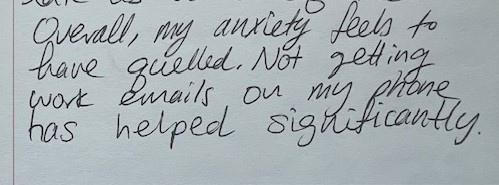Home / Blog
Becoming a Communications Professional
How I settled into a new role from dataviz design.

Table of contents
My boyfriend had a medical emergency a year ago, and I had to take over driving duties. I hate driving and only got behind the wheel when I had to. At first, I was so nervous on the road, my heart was beating very fast and my palms were sweaty. After three months of daily driving, something shifted, and I realized I was calm. What brought about this change?
Around the same time, I had a lot of anxiety at work. I pivoted from dataviz design to communications, and even though I had a lot of transferrable skills, there were skill gaps I had to fill in. In the early days, I felt inadequate in my role. Was I doing a good job? Am I even the right fit? How do I know if what I am doing is correct? I regularly doubted myself.
My situation improved a year into my job as I developed my own processes. Like driving, I gained confidence as I had more experience by making many mistakes and learning from them. Of course, this is easier said than done.
If you recently transitioned into a new field and you’re feeling uncertain about your ability to do a good job, I’ll share a few ideas you could try and work towards building competence and confidence.
Gain confidence by developing your hard and soft skills
It can be frustrating in the early part of your job when you don’t know what you’re doing, making mistakes more often than you like. Relax. It’s okay to make mistakes as long as you learn from them. In fact, this is a sign you have space to grow, which is a great starting point.
Identify areas you’re weak in or could use an extra boost. Learn the tools and processes of your profession.
If you’re stuck on where to start, look at similar job postings of your role. You’ll notice skills that are frequently listed. In many communications job postings, the top 3 skills that keep coming up are:
- written communication
- performance tracking
- team collaboration
I’ll go through how I developed these skills in more detail.
Going back to the basics with writing
I believed I had decent copywriting skills until I saw a colleague perform writing magic. She wrote with so much warmth and personality while we were collaborating on an email in Google Docs. My writing in comparison was rigid and robotic. My initial response was to feel ashamed and question my competence; I doubted my abilities and wondered if I was the right person for this job.
Despite feeling helpless, I still wanted to give myself a chance. First, I asked my colleague for feedback on how I could improve my writing (she said it helped to write with a welcoming attitude). Second, I studied her writing closely to learn from her sentence structures (I discovered her tendency to thread long sentences together, creating a nice flow of words). Finally, I went back to the basics by enrolling in online courses and reading books on writing and communication.
Through the culmination of all of these efforts in the span of many months, I noticed small but significant progress in my writing skills. For example, I understood the importance of concise writing and the effectiveness of an active voice.
Writing tools such as Grammarly and ProWritingAid have also been very helpful to improve my grammar and style. I’ve recently incorporated ChatGPT into my process to brainstorm various phrases and idioms.
Creating opportunities to learn performance tracking
It’s unlikely that your job will allow you to learn all the skills you’re interested in. Performance tracking is a critical skill for any communications specialist to optimize workflows and measure marketing efforts. However, my role didn’t prioritize this and I had no immediate opportunities to learn it. So I had to get creative and develop a way to learn this skill.
I started small by setting up a spreadsheet to collect monthly data on how we’re doing, such as social media follows and newsletter subscribes. Then, I created a new process to update this information at the end of each month. Not too long after establishing this process, I discovered a bug in our system: one of our newsletters had an abnormally high amount of links clicked. After digging into this, I learned about link checking, which is done by email vendors to check for spam. This affected the accuracy of our engagement report, which is important in gauging the type of content our members are interested in. It was a huge relief to validate the importance of performance tracking this way and it solidified my belief that this was a skill I had to keep honing.
Collaborating effectively in a remote team
Remote work comes with a whole host of benefits, such as flexibility to work in the comfort of your home, but it also has some drawbacks. Since I only had experience working at an office, communicating asynchronously with my team has been especially challenging.
The goal of our communications effort is to deliver messaging about programs and initiatives my team is developing to our audience and the general public. So it’s critical I establish a good relationship with my team and earn their trust. However, building trust over Slack and email is a slow burn process, it doesn’t compare to face-to-face interactions.
There have been several instances where I’ve misunderstood what someone said on Slack which spiraled into a long thread of conversations that could’ve been resolved with a 15-minute call. Sometimes, I may have rubbed someone the wrong way when I didn’t intend to. There isn’t a magic bullet to mitigate this other than practice and experience. Observing and learning how my team members communicate asynchronously has also been very helpful for me.
Data-led reflections
I record events of the day in a planner and reflect on what went well or what could’ve been better. It’s been extremely useful to help me do more of what makes me feel good. The best days happened because I had a great call with a colleague and felt aligned with the work we were doing. So I started to seek more ways to connect with them.
My planner also helps me look for solutions when I am struggling with something. Sometime in May, I was experiencing intense anxiety the moment I woke up. For a few weeks, I ignored the feeling and thought it would go away eventually, but it didn’t. My daily entries kept mentioning my morning anxiety, so I thought about what triggered them. Eventually, I pinpointed it down to checking work emails first thing when I woke up. Aha, maybe that was the cause. I logged off my work emails on my phone and silenced chat notifications. My condition significantly improved since and my anxiety is more manageable now.

On May 18th, I wrote: woke up feeling anxious, but it's not as bad as previous days. I've been feeling this way for some time now and started to notice it as a pattern.

This was recorded on May 22nd, just a few days after I shut off work emails and chat on my phone. My anxious was noticeably better.
Keeping a record of your day is a form of data collection. When we collect enough of it over a period of time, patterns emerge and it’s an opportunity to change ourselves for the better. I know the idea of keeping one can feel overwhelming to some, especially if you don’t have a habit of using one. You can still reflect by taking a walk and thinking through how your day went.
Signs of becoming your role
Now you’ve put in all this work to expand your knowledge, how do you know if you actually made progress?
In my experience, there are three things you could look for.
-
Are you noticing details (relevant to your role) that others would easily overlook? One of my design teachers is an architect and she’s taken many photos of sidewalks to reference for projects. When was the last time you closely inspected a sidewalk for its colour, material, or form? You begin to develop expertise when you start spotting things people outside your field easily overlook.
-
Owning and contributing new ideas. When you’re just starting out, you spend a lot of time adjusting to your work environment to understand how things are run. You won’t necessarily have your own ideas or opinions about things yet. It might be small at first, perhaps offering a suggestion during a meeting. Or, it might be big, you may occasionally see opportunities to optimize a process or address an existing problem. When you put together your ideas and present them to the wider team, that’s a sign you’re becoming a valuable team member.
-
Being proactive and asking questions. The first time I supported an annual event, I had no idea what I was doing. However my second time working on it was a completely different story. To prepare for major announcements, I set up communications templates and proactively asked the team if we had any information ready so I am not doing things last minute again. Experience has taught me to think a few steps ahead so I don’t repeat my mistakes.
Don’t become jaded
The opposite of becoming my role was being jaded.
Being jaded is a miserable experience riddled with self-hatred and shame. My period of jadedness surrounded my thoughts with insecurity and was exacerbated by mistakes I made at work. Instead of actively learning from it, I reactively felt insecure which was not a productive feeling.
Eventually, I just focussed on upskilling and that was a huge turning point. My goal was to improve and when I demonstrated progress, I felt so proud of myself. As I got better at my job and felt more comfortable in my role, I was slowly becoming a communications professional. I was no longer jaded. Sure, things still get tough and I struggle, but overall, I’m a lot more content these days.
I hope by sharing my experiences here, it gives you some motivation to focus on self-improvement and the progress you make. Actively work to not be jaded and you will enjoy your work so much more than you thought was possible.
